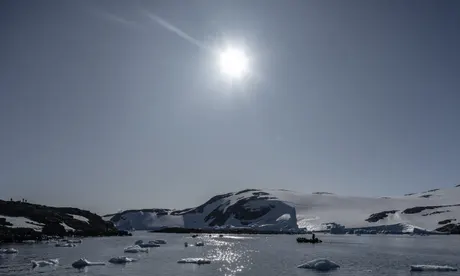Recent US government data shows that the temperature of the world’s ocean surface has hit an all-time high since satellite records began, leading to marine heatwaves around the globe.
The average temperature at the ocean’s surface has been at 21.1C since the start of April – beating the previous high of 21C set in 2016, climate scientists said, quoting preliminary data from the National Oceanic and Atmospheric Administration (NOAA).
“The current trajectory looks like it’s headed off the charts, smashing previous records,” said Prof Matthew England, a climate scientist at the University of New South Wales.
Temperatures have been suppressed by three years of La Niña conditions across the vast tropical Pacific while the effect of rising greenhouse gas emissions has also been dampened.
However, scientists said heat was now rising to the ocean surface, pointing to a potential El Niño pattern in the tropical Pacific later this year that can increase the risk of extreme weather conditions and further challenge global heat records.
Characterised by cooling in the central and eastern tropical Pacific and stronger trade winds, La Niña periods have a cooling influence on global temperatures. Ocean temperatures in those regions are warmer than usual and global temperatures are pushed up during El Niño periods.
According to the NOAA data that is driven mostly by satellite observations but also verified with measurements from ships and buoys and does not include the polar regions, the second-hottest globally averaged ocean temperatures coincided with El Niño that ran from 2014 to 2016.
More than 90% of the extra heat caused by adding greenhouse gases to the atmosphere from burning fossil fuels and deforestation has been taken up by the ocean.
A study last year said the amount of heat accumulating in the ocean was accelerating and penetrating deeper, providing fuel for extreme weather.
Read also: Japan’s three megabanks to face votes on climate change
Measurements from the top 2km of the ocean show the rapid accumulation of heat in the upper parts of the ocean, particularly since the 1980s when temperature rises had been “almost linear”, according to Dr Alex Sen Gupta, an associate professor at the UNSW Climate Change Research Centre.
“What’s been surprising is that the last three years have also been really warm, despite the fact that we’ve had La Niña conditions,” he said. “But it is now warmer still and we are getting what looks like record temperatures.”
Current observations show moderate to strong marine heatwaves in several regions, including the southern Indian Ocean, the south Atlantic, off north-west Africa, around New Zealand, off the north-east of Australia and the west of Central America.
“It’s unusual to see so many quite extreme marine heatwaves all at the same time,” said Sen Gupta.
While marine heatwaves can be driven by local weather conditions, studies have shown they have increased in frequency and intensity as the oceans have warmed – a trend forecast to worsen with human-caused global heating.
Hotter oceans provide more energy for storms, as well as putting ice sheets at risk and pushing up global sea levels, caused by salt water expanding as it warms.
Story was adapted from the Guardian.
